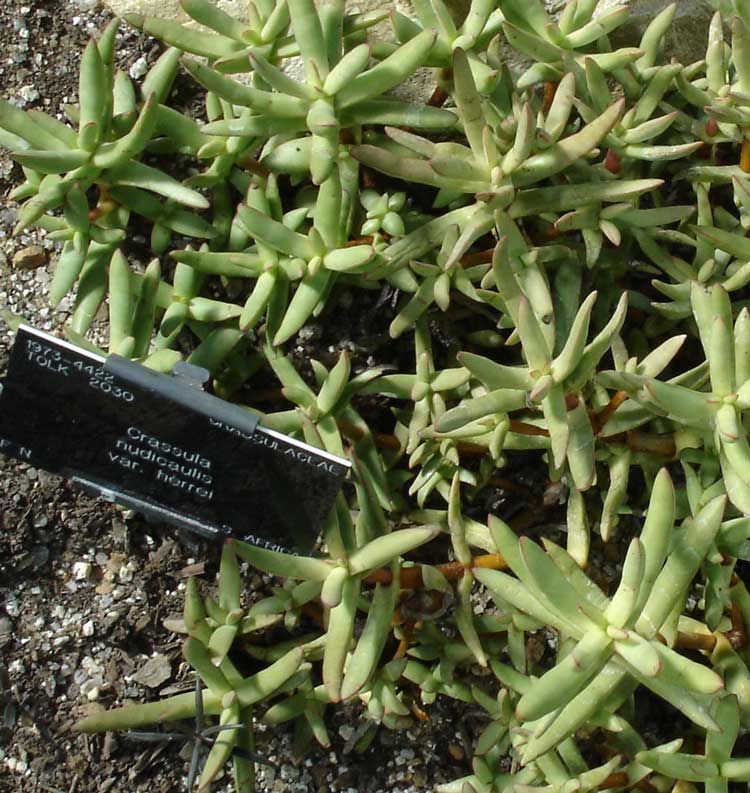
Crassula nudicaulis (*)
Classification System: APG IV
Superregnum: Eukaryota
Regnum: Plantae
Cladus: Angiosperms
Cladus: Eudicots
Cladus: Core eudicots
Ordo: Saxifragales
Familia: Crassulaceae
Subfamilia: Crassuloideae
Genus: Crassula
Subgenus: C. subg. Crassula
Sectio: C. sect. Globulea
Species: Crassula nudicaulis
Varieties: C. n. var. herrei – C. n. var. platyphylla
Name
Crassula nudicaulis L., Sp. Pl. 283 1753.
Synonyms
Crassula canescens (Haw.) J. A. Schult.
Crassula canescens (Haw.) Sweet
Crassula canescens var. angustifolia (Eckl. & Zeyh.) Harv.
Crassula cephalophora Thunb.
Crassula cephalophora var. basutica Schönland
Crassula cephalophora var. thunbergii Schönland
Crassula hirta Thunb.
Crassula hirta var. dyeri Schönland
Crassula nudicaulis var. glabra Schönl.
Crassula obvallata L.
Crassula sulcata (Haw.) Dietr.
Globulea canescens Haw.
Globulea canescens var. angustifolia Eckl. & Zeyh.
Globulea capitata Salm-Dyck ex Haw.
Globulea lingua Haw.
Globulea nudicaulis (L.) Haw.
Globulea obvallata (L.) Haw.
Globulea sulcata Haw.
Purgosea cephalophora (Thunb.) G. Don
Purgosea hirta (Thunb.) G. Don
Sedum canescens (Haw.) Kuntze
Distribution
Native distribution areas:
Continental: Africa
Regional: Southern Africa
South Africa (North-West Prov., Gauteng, Free State, KwaZulu-Natal, N-Cape Prov., W-Cape Prov., E-Cape Prov.), Lesotho
References: Brummitt, R.K. 2001. TDWG – World Geographical Scheme for Recording Plant Distributions, 2nd Edition
References
Primary references
Linnaeus, C. 1753. Species plantarum, exhibentes plantas rite cognitas, ad genera relatas, cum differentiis specificis, nominibus trivialibus, synonymis selectis, locis natalibus, secundum systema sexuale digestas. Tomus I. Pp. [I–XII], 1–560. Impensis Laurentii Salvii, Holmiae [Stockholm]. BHL Reference page. : 283.
Links
Hassler, M. 2019. Crassula nudicaulis. World Plants: Synonymic Checklists of the Vascular Plants of the World In: Roskovh, Y., Abucay, L., Orrell, T., Nicolson, D., Bailly, N., Kirk, P., Bourgoin, T., DeWalt, R.E., Decock, W., De Wever, A., Nieukerken, E. van, Zarucchi, J. & Penev, L., eds. 2019. Species 2000 & ITIS Catalogue of Life. Published on the internet. Accessed: 2019 November 24. Reference page.
Govaerts, R. et al. 2019. Crassula nudicaulis in Kew Science Plants of the World online. The Board of Trustees of the Royal Botanic Gardens, Kew. Published on the internet. Accessed: 2019 November 24. Reference page.
International Plant Names Index. 2019. Crassula nudicaulis. Published online. Accessed: November 24 2019.
Tropicos.org 2019. Crassula nudicaulis. Missouri Botanical Garden. Published on the internet. Accessed: 2019 November 24.
USDA, ARS, Germplasm Resources Information Network. Crassula nudicaulis in the Germplasm Resources Information Network (GRIN), U.S. Department of Agriculture Agricultural Research Service. Accessed: 07-Oct-06.
Vernacular names
Crassula nudicaulis is a succulent plant native to South Africa (the Cape Provinces, the Free State, KwaZulu-Natal and the Northern Provinces), and Lesotho.[1]
Description
Both hairy and smooth-leaved Crassula nudicaulis var. nudicaulis specimens of a long-leaved form
Crassula nudicaulis is a perennial succulent herb with a thickened taproot and several low rosettes of basal leaves. Plants are somewhat variable in appearance and there are several subspecies over the plant's wide range.
The leaves of this species can turn brown, but they do not adopt the brick red hues sometimes taken on by Crassula subacaulis and Crassula clavata.
The inflorescence is a spike, with bracts that are not ciliate; the lowest one to three pairs of bracts have no flowers in the axils but the others do. The flowers are turned upwards, they have yellow anthers and distinctive dorsal appendages.
This species is closely related to Crassula cotyledonis, which is a more robust species that has marginal leaf-hair in more than one line. It can also be confused with Crassula clavata, but that species has glabrous (smooth), oblanceolate-obovate leaves that turn deep purple-red in the sun.[2][3]
Subspecies variation
This species is variable, and several subspecies exist:
subsp. nudicaulis: The nominate subspecies has oblong-elliptic (cylindrical), reddish-green leaves that are 50 to 80 mm (2 to 3 in) long and faintly pubescent.
subsp. herrei: This Richtersveld subspecies has shorter, thicker, more fleshy, hairless leaves, 30 to 40 mm (1.2 to 1.6 in) long, but can grow into a shrubby bush up to 25 cm (10 in) tall.
subsp. platyphylla: This southern Karoo subspecies has blue-grey foliage; the leaves are broadly oblong to orbicular with cilia near the margins.
C. nudicaulis var. nudicaulis
C. nudicaulis var. herrei from the Namaqualand and Richtersveld regions.
C. nudicaulis var. platyphylla from the southern Karoo region
Distribution and habitat
Crassula nudicaulis is native to southern Africa where its range extends from the Western Cape to the Eastern Cape, KwaZulu-Natal, Free State and Lesotho. Its habitat is hillside and mountain slopes.[2]
Cultivation
Crassula nudicaulis is easy to grow as a potplant in a gravelly medium. Mealy bugs and fungal diseases can cause problems, and over-watering should be avoided. Propagation is by division, offsets or leaf cuttings.[4]
References
"Crassula nudicaulis". Germplasm Resources Information Network (GRIN). Agricultural Research Service (ARS), United States Department of Agriculture (USDA). Retrieved 23 November 2014.
Doreen Court (2000). Succulent Flora of Southern Africa. CRC Press. p. 92. ISBN 978-90-5809-323-3.
Crassula nudicaulis - Operation Wildflower
"Crassula nudicaulis: Naked-stalked Crassula". World of succulents. 10 November 2016. Retrieved 27 November 2016.
Retrieved from "http://en.wikipedia.org/"
All text is available under the terms of the GNU Free Documentation License

